Brazil is one of the leading global markets for food delivery, and the trend points to continuous growth. Delivery platforms have been investing in variety and quality, expanding the options available to consumers.
In this context, estimates suggest that the country will have 90.5 million delivery users by the end of 2029, according to Statista data. This means the number will approach half of Brazil’s population.
With this growth, companies in the sector seek to serve new audiences more efficiently, which also increases demand.
Food delivery continues to expand among Brazilians
Currently, about 40% of Brazilians use delivery platforms, according to a Ticket survey. After the growth spurred by the pandemic, the segment maintained its upward trajectory due to the pursuit of convenience and speed in daily life.
Globally, the sector is expected to generate $1.4 trillion in 2025, according to Statista. Additionally, the number of consumers will continue to rise, potentially representing about one-third of the world’s population by the end of 2029.
In Brazil, iFood leads the market, but an increasing number of restaurants have invested in their own delivery platforms. Moreover, economic uncertainties make delivery an attractive alternative, as it allows for optimizing operational costs.
Profile of delivery consumers in Brazil
The growth in delivery demand is directly linked to changes in consumption habits. The Ticket survey revealed relevant data about the profile of Brazilians who use these services.
Generation Z, composed of people aged 15 to 28, is the primary audience for delivery, with 51% of this group using such platforms. This age group, more digitalized and connected to technological innovations, is more familiar with online services.
The most frequent orders include fast food like burgers and pizzas, as well as traditional Brazilian dishes and meats. At the same time, healthy food consumption grew by 98% in recent years, according to Sebrae.
Additionally, the increased demand for natural and vegan options has led platforms to diversify their offerings in this segment.
Challenges and opportunities for the sector
Despite the growth, the delivery market faces challenges, especially for new companies, given that iFood holds 80% of orders. However, the adoption of proprietary platforms by restaurants and supermarkets is gaining traction.
An established trend is the dark kitchen model, which operates as kitchens for delivery, with no in-person service. Statista projects that by 2030, this format will account for half of global delivery services.
Artificial intelligence has also been incorporated into the sector to personalize service based on consumer behavior. Data analysis enables more efficient meal and promotion offerings.
Logistics remains a challenge, whether for quick deliveries in large urban centers or reaching more remote regions. As a result, solutions like automated routes and autonomous vehicles are being tested by companies in the sector.
The rise in demand also reinforces the need for menu variety. Companies prioritizing specific diets and dietary restrictions can stand out amid competition.
Growth trend expected to continue in the future
In Brazil, the food delivery market is expected to reach $21.18 billion in revenue by 2025. The projection is an annual growth of 7.05% until 2029, reaching $27.81 billion.
With the expansion of dark kitchens and advancements in technological innovations, delivery is likely to become even more accessible, extending its reach to other segments of the food industry.


